In today’s digital-first economy, the ability to accept electronic payments is no longer a luxury—it’s a necessity. From a corner coffee shop to a global e-commerce giant, every business needs a reliable way to process transactions. This demand has made the payment processing business a lucrative and rapidly growing industry. But what exactly is a payment processing company, and how do these vital cogs in the financial machine operate? This comprehensive guide will dissect the entire ecosystem, from the foundational principles of a payment processing system to the intricate steps required to start your own credit card processing business. Whether you are a business owner seeking the best payment processing solution or an entrepreneur asking, “how do I become a credit card processor?”, this article will provide you with the answers you need to navigate this complex yet rewarding field.
We will delve into the various components that make up a successful payments business, including the technology, the legal and compliance hurdles, and the different business models you can pursue. From a simple payment processing franchise to building a full-scale payment gateway company, the opportunities are vast. Our goal is to provide a detailed and human-centered roadmap that demystifies the process of becoming a key player in the financial processing world. By the end, you will have a clear understanding of the entire payment process and the strategic steps required to succeed in this competitive landscape.
What is a Payment Processing Company: Defining the Digital Intermediary
At its core, a payment processing company is a financial services business that acts as a vital intermediary in electronic financial transactions. Their primary function is to facilitate the secure transfer of funds between a customer’s bank (the issuing bank) and a merchant’s bank (the acquiring bank). Without a payment processor, a merchant would not be able to accept payments from credit cards, debit cards, or digital wallets. These companies are the silent engines that power everything from in-person card swipes to online purchases. The entire system is built on speed, security, and efficiency, and the payment processing company is responsible for ensuring all three. The role is much more than simply moving money; it’s about protecting sensitive data and ensuring compliance every step of the way.
The entire flow of a transaction, known as the payment process, is a complex sequence of events that a payment processing company manages. It begins when a customer enters their card information and ends when the funds are settled in the merchant’s account. This process, which often takes mere seconds, involves a secure chain of communication between various parties, including the merchant’s payment terminal or e-commerce site, the payment gateway, the payment processor, the card network, and the banks on both sides of the transaction. A payment processing business provides the technology and services that make this secure and rapid communication possible. They are the backbone of modern commerce, handling the sensitive and mission-critical task of moving money.
The Anatomy of a Payment Processing Business: Key Players and Components
To truly understand a payment processing company, you must first grasp the different entities that collaborate to make a single transaction possible. The system is a finely tuned machine, with each component playing a distinct and crucial role. From the moment a customer clicks “pay” to the final settlement of funds, multiple parties work in concert to ensure the transaction is completed securely. This is a crucial element for anyone who wants to start a credit card processing business or a broader payment processing business.
The Merchant and the Customer: The Initiators of the Payment Processing
The merchant is the business accepting the payment, whether it’s a physical store or an online retailer. The customer is the individual making the purchase. Both are at the very beginning of the transaction chain. Their interaction sets the entire financial processing flow into motion. Without a secure and seamless experience, the transaction can fail, leading to lost sales and a poor customer experience. This highlights the importance of choosing the right payment processing company that can provide a smooth and reliable service.
The Payment Gateway: The Digital Secure Door for Payment Processing Services
The payment gateway is the software component that connects the merchant’s website or point-of-sale system to the payment processor. It encrypts the customer’s sensitive card information and securely transmits it to the processor. The gateway acts as a digital secure door, protecting data from unauthorized access during transmission. It is an essential element for any business that accepts payments online and a key part of the online payment processing franchise model. Without a robust gateway, a merchant’s business would be at a significant security risk, making this a non-negotiable part of any payment processing system.
The Payment Processor: The Brains of the Credit Card Processing Business
The payment processing company, or payment processor, receives the encrypted data from the gateway. It then routes the transaction information to the appropriate card network (like Visa, Mastercard, or American Express) and the issuing bank. The processor is responsible for obtaining authorization for the transaction and sending the response back to the merchant. This is the core function of any credit card processing business. They handle the complex logistics of moving funds between banks, ensuring that every detail is correct and secure. This is the heart of the entire payments processing companies ecosystem.
How to Start a Payment Processing Company: A Step-by-Step Guide
The thought of starting a payment processing business can seem daunting, but with a clear plan, it is an achievable goal. The industry is highly regulated and requires significant planning and investment, but the rewards can be substantial. For those who are asking “how to start a payment processing company,” the journey involves more than just a great idea. It requires a strategic approach to technology, partnerships, and compliance. This guide provides a detailed blueprint for anyone who wants to become a payment processor and establish a successful credit card processing business.
Step 1: Market Research and Business Planning for a Payment Processing Business
Before you can start a payment processing company, you must first understand the market. Who is your target customer? Are you focusing on small businesses, e-commerce stores, or specific industries like restaurants or healthcare? Your niche will determine the services you offer and the technology you need. Develop a comprehensive business plan that outlines your business model, pricing strategy, marketing plan, and financial projections. A well-defined plan is the foundation of any successful venture and is a critical first step when you are thinking about starting a credit card processing company. It’s the difference between a viable business and a pipe dream. A strong plan will also be essential when you seek partnerships and funding.
Step 2: Legal, Licensing, and Compliance for a Credit Card Processing Business
The payment industry is heavily regulated. To start a payment processing business, you must comply with a number of legal and regulatory requirements. The most important of these is the Payment Card Industry Data Security Standard (PCI DSS). This is a set of security standards designed to ensure that all companies that accept, process, store, or transmit credit card information maintain a secure environment. You must also establish robust anti-money laundering (AML) and Know Your Customer (KYC) procedures. These are non-negotiable steps to ensure that your business operates legally and securely. Navigating this landscape is a key part of how to become a payment processor and is one of the biggest challenges you will face.
Step 3: Building Financial Partnerships to Become a Payment Processor
You cannot operate as a payment processing company without strong relationships with financial institutions. You will need to partner with an acquiring bank that will sponsor you and facilitate the settlement of funds. These partnerships are critical for your business and can be difficult to secure. They are also a key element of the business model for anyone who wants to start a credit card processing business. A strong relationship with an acquiring bank will determine the rates you can offer your customers and the types of services you can provide. These partnerships are the lifeblood of the payments processing companies ecosystem and a crucial step for anyone asking “how to start a merchant services business?”.
Step 4: Technology and Infrastructure for a Payment Processing System
This is where you decide if you will build your own payment processing software from scratch or use a white-label solution. Building a custom solution can be expensive and time-consuming, requiring a team of experienced developers and a significant investment in secure infrastructure. A white-label solution, on the other hand, allows you to use a pre-built platform and brand it as your own. This can be a faster and more cost-effective way to get started and is a common path for those who are looking to start a credit card processing company without a large capital investment. The choice between these two options will have a major impact on your business model and your time to market. This is also where you will consider how to make a payment gateway or how to build a payment gateway, which is a key component of your platform.
How Emagia Helps: Revolutionizing the Payment Process
While the intricacies of starting a payment processing company are vast, a modern business must also contend with the complexities of managing the payments once they are received. This is where Emagia’s Autonomous Finance platform provides a transformative solution. Emagia specializes in automating the accounts receivable process, which is the final, critical step after a payment has been processed. Their platform seamlessly integrates with any payment processing system, intelligently collecting and applying payments to open invoices. Instead of a finance team manually reconciling payments from various sources—credit cards, ACH transfers, and wires—Emagia’s AI-powered system automatically matches and applies cash with near-perfect accuracy. This goes beyond the function of a simple payment processor by solving the post-payment reconciliation problem, which is a major source of financial friction for businesses. The platform handles everything from automated payment reminders to AI-driven cash flow forecasting. By taking care of the entire order-to-cash cycle, Emagia allows businesses to focus on what they do best, knowing that their payments are being processed and managed with unparalleled efficiency and intelligence. This makes the entire financial processing workflow more streamlined and effective, providing a competitive advantage far beyond what a basic payment processing solution can offer.
FAQ: Frequently Asked Questions
What is the difference between a payment processor and a payment gateway?
A payment gateway and a payment processor are two distinct but interconnected parts of the payment ecosystem. The payment gateway is the technology that securely encrypts and transmits payment data from a merchant’s website or POS terminal to the processor. The payment processor, on the other hand, is the company that receives this data, routes it to the correct banks and card networks for authorization, and facilitates the settlement of funds. You can think of the gateway as the secure entry point and the processor as the engine that drives the transaction.
How much does it cost to start a payment processing company?
The cost of starting a payment processing business can vary dramatically, but it is a capital-intensive venture. The expenses include legal and licensing fees, development costs for software and infrastructure (which can be over a million dollars for a custom build), ongoing compliance costs, and staffing. A more affordable option, such as a payment processing franchise or a white-label solution, can significantly lower the initial investment, making it a more accessible entry point for new entrepreneurs.
How do I become a merchant service provider?
To become a merchant service provider, you can either become a full-fledged payment processor or, more commonly, an Independent Sales Organization (ISO) or agent. As an ISO, you partner with an established processor to sell their services to merchants. You handle the sales and client relationships, while the processor manages the technology, compliance, and settlement. This is a popular way to enter the credit card processing business without the heavy investment required to build your own infrastructure.
Is starting a payment processing company a good business?
Yes, starting a payment processing company can be a very good business due to the high demand for digital payment solutions. The industry offers high earning potential through transaction fees and recurring revenue. However, it is also a very competitive and highly regulated market. Success requires a strong business plan, significant investment in technology and compliance, and a clear understanding of the market. For the right entrepreneur, it is a rewarding and profitable venture.
What is a payment processing franchise?
A payment processing franchise is a business model where an individual or company can use the brand, technology, and support of a larger, established payment processing company in exchange for a fee. This model is often promoted as a low-cost, low-risk way to enter the industry, as it provides a ready-made platform and sales support. It is a way for an individual to get into the payment processing business without having to build the entire infrastructure from scratch.



